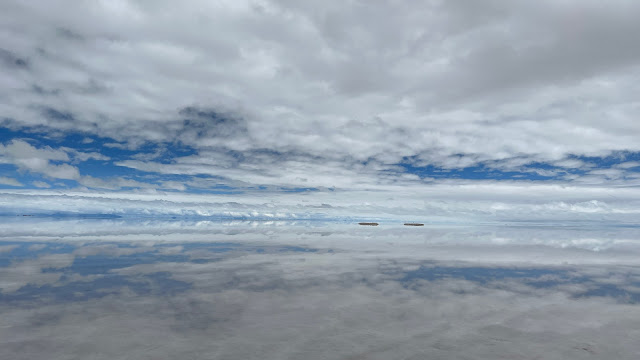Lake Titicaca is a name that conjurs up echoes from my childhood. We were on our way to stay on the Isla del Sol (not far from the Island of the Moon!) at the southern part of this massive lake, the world’s highest navigable lake. It is situated near the
border of Bolivia and Peru. The beautiful Isla del Sol was known to its early inhabitants as Titi Khar'ka, the 'rock of the puma' from which Lake Titicaca gets its name. It is believed to be the birthplace of the Inca Empire and the birthplace of Andean spirituality and culture: legend has it that the Sun created a man and a woman (Manco Capac and his sister-wife Mama Ocllo) on Sun Island. Evidently once the priests and chosen ones from Machu Picchu came here to study. The island and surrounding shores still bear the results of the industry of the amazing Inca empire - millennia-old stone-walled terraces cover every slope. But we were still to arrive!
 |
| The border between Bolivia and Peru passes through the centre of the lake south to north |
It was an early morning start which almost didn’t start because someone forgot to set the alarm, or rather she set it to PM rather than AM. OMG and sacre bleu! We were to be picked up at 7:15 and we were woken by the soft burr of the phone at 7:07 - our guide was downstairs "but don’t rush" he said. Whaaa! We were out of bed, washed, dressed, damp washing stuffed into our bags, zipped up and in the lobby 11 minutes later - my eyes were only just open. We scoffed breakfast in 10 mins with the anxious diminutive Geronimo hovering over us, darling man (we understood we’d have a boxed breakfast to take - lots of miscommunication at this particular part of our travels). We made it to the bus station 30mins after we woke - with a lot of time to spare. I think we must have set some kind of record!
The 2-3hr bus trip gave us a chance to see a little more of Bolivia’s countryside before reaching the lake. Towards the end of the trip we hopped off the bus and were loaded on to a small ferry boat in order to cross the Strait of Tiquina which joins the northern main lake and the southern smaller lake both of which form Lake Titicaca. The passage is almost 1km wide and is deep and fast flowing. The little villages on either side of the Strait, San Pablo de Tiquina and San Pedro de Tiquina provide a nonstop barge service for cars and large vehicles alike and that provides a livelihood for many locals. Currently there is some heated debate about whether a road bridge should be built.
 |
| Strait of Tiquina. Fish farms in the foreground (the Lake has been practically depleted of fish) |
 |
| Fascinating to watch large buses being ferried across the Strait |
 |
| We passengers crossed separately. |
 |
| That fringe of trees on the skyline are eucalypts. We saw many in this region of Bolivia |
 |
| This statue of Manco Capac welcomed us to the Lake |
Once across the Strait we headed across the Copacabana Peninsula to Copacabana where we eventually boarded a ferry which would take us to our island. There seemed to be quite some 'negotiating' going on (often) - we tourists are a captive, rather helpless market. While we waited we went for a stroll and took some pix of this popular holiday destination.
 |
| This wee poppet captured my heart. |
 |
| There is a naval base on the shores of the lake. |
 |
| A number of Acacias in flower dotted the shore |
 |
| Juan and Lindsay taking our bags to the wharf area - while I lagged behind taking pix. |
We eventually arrived at Sun Island 4200m above sea level, blurry-eyed and short of breath but excited about the tranquility that awaited us on the island. The lodge where we were staying was right on the water's edge - quite idyllic albeit fairly basic.
Our hosts welcomed us with a late feast served on the terrace overlooking the lake. Sardines, trout, chicken, dried black potato, eggs, baked banana, corn tortilla, the best fava beans I've ever tasted, cheese and huge white corn. Man, oh man! and then dessert came out! We left the table groaning, but we lined up again that evening for more delicious food. As the sun sank below the distant mountains, the chill set in. Our cabin was not heated but while we were eating dinner, our hosts lit a small fire in our room - kero or some such. It was very effective.
 |
| The view from our cabin - tranqility plus |
 |
| Snow-capped Cordillera Real |
































































